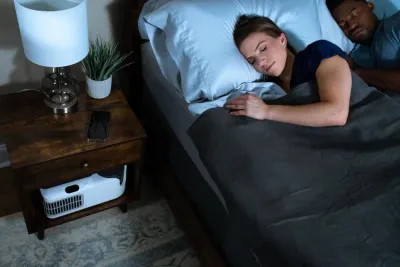Pink Noise for Sleep: A Gentle Alternative to White Noise
Chilipad Editorial Team • Jan 26, 2023

Key Takeaways
Pink noise can help improve sleep by creating a steady, calming sound environment that supports deeper sleep and fewer nighttime disruptions.
- Pink noise has a softer, more balanced sound profile than white noise, which many people find easier to sleep with.
- Studies suggest pink noise may help stabilize brain activity during deep sleep, supporting memory consolidation and mental recovery.
- The consistent sound can mask sudden noises, helping you fall asleep faster and stay asleep longer.
- Because it resembles natural sounds like rainfall or rustling leaves, pink noise creates a relaxing background that promotes sleep readiness.
Getting a good night's sleep becomes a challenge when interrupted by the hustle and bustle of city life, noisy neighborhoods, your partner, or even a snoring pet. While you're asleep, your brain still processes these sounds, which can lead to a drop in sleep quality.
However, certain kinds of sounds—consistent and gentle—can enhance sleep. These soothing ambient sounds can draw out disruptive noise and can even positively influence brain waves.
While white noise is a popular sleep aid, but research suggests that pink noise might be an even better option. Pink noise emphasizes lower frequencies compared to white noise, offering a softer, more calming effect. [1]
The lower pitch of pink noise compared to white noise helps to minimize external auditory disruptions, paving the way for a deeper and more restorative sleep. This leads to all the beneficial outcomes of a full night's sleep.
What is Pink Noise?
Pink noise is a type of sound where every octave, which is a range of frequencies, has an equal amount of noise energy. It's similar to white noise, but it emphasizes lower frequencies, making it deeper and more even than white noise.
Due to the way the human ear functions, pink noise is perceived by individuals as having a uniformly balanced volume across all frequencies, resulting in a pleasing sound. [2]
The 'pink' part of its name doesn't refer to the color but rather the way the noise is distributed across the frequency spectrum. In pink noise, the power per hertz decreases as the frequency increases, which results in a sound that many people find softer and more pleasant than white noise.
This quality makes it effective for masking disruptive background sounds, providing a soothing backdrop that can enhance sleep quality.
Common examples of pink noise in nature include steady rainfall, wind rustling through leaves, or waves crashing on a beach. Compared to white noise, these sounds have a fuller quality. Pink noise is commonly used for sleep therapy and relaxation because of its balanced and calming nature.
Sleep Study: In 2017, a team of researchers at Northwestern University conducted a study that showed that playing pink noise during the night can improve deeper sleep and memory consolidation in older adults. The participants' brain activity was measured during sleep. [3]
Enhance Your Sleep with Chilipad
Upgrade your sleep experience with our Chilipad bed cooling systems, designed to complement the calming effects of pink noise for unparalleled sleep.
Benefits of Pink Noise
Discover the amazing benefits and how it can improve your sleep patterns.
- Improves Sleep Quality: Pink noise is a type of sound that has a consistent frequency, which can help to promote deeper and more stable sleep.
- Enhances Brain Activity: Studies have shown that pink noise can enhance the brain activity related to the deep sleep phase, which can assist in memory and learning.
- Reduces Sleep Disruptions: The soothing sound can minimize the effect of disruptive environmental noises, helping you stay asleep.
- Supports Relaxation: The soft, consistent sound can help calm the mind and relax the body, making it easier to fall asleep.
- Boosts Overall Well-being: Getting better sleep can improve overall health, including enhanced mood and cognitive function.
- Helps in Managing Tinnitus: Pink noise can provide background sound for those suffering from tinnitus, masking the ringing and assisting in better sleep.
Did You Know: Most people prefer pink noise over white noise when sleeping. As a result, many are switching to more stylish pink noise machines.
Pink Noise vs White Noise
In terms of being a sleep aid, pink and white noise are similar. Both contain frequencies across the sound spectrum, so both can mask annoying sounds. However, we perceive pink noise and white noise differently: white noise sounds like hissing or television static, while pink noise has a deep, whooshing sound like wind, rain, ocean waves, or rustling leaves.
How to Use Pink Noise
Living in a noisy area can be difficult, but heavy rainfall can bring a sense of calm by blocking out the sounds of voices and traffic. Unfortunately, we cannot control the weather.
An effective solution to block out unwanted background noise while sleeping is to play pink noise throughout the night. Pink noise can help some people fall asleep within an hour, while others prefer playing it throughout the night to avoid being disturbed. Here are some methods to incorporate pink noise into your bedtime and sleep routine, for a better night's sleep.
Pink Noise Examples
Here are some common examples of pink noise you might recognize:
- Waterfall
- Steady Rainfall
- Ocean Waves
- Wind
- Flowing River
- Heartbeat
- Rustling Leaves
Urban noises, particularly those generated by traffic, have been found to have similar qualities to pink noise. [4] Because pink noise resembles everyday sounds, therapists use it as an effective tool to address hearing disorders and tinnitus, a condition marked by ringing in the ears. [5]
Pink Noise Playlists
If you're looking to listen to pink noise, you don't have to spend any money. You can easily find tracks of white, pink, or brown noise on platforms like YouTube and Spotify, or you can download continuous noise apps such as Sleep Sounds and White Noise Lite.
Tip: Consider purchasing a sound machine or noise generator that provides options for white, pink, or brown noise.
When it comes to generating sound to help you sleep, the hardware you choose depends on personal preference. While playing pink noise from a speaker can be more comfortable, it may not be as effective at blocking out other sounds. On the other hand, earphones or headphones are better at masking sounds, but they can be uncomfortable, especially if you sleep on your side with one ear against the pillow.
Pink Noise Machines
Do you have trouble sleeping at night? Sound machines or white noise machines are compact electronic devices with built-in speakers that can typically play white noise, pink noise, and other sounds to help block out background noises.
They are often used to improve the sleep of infants and are also a good option for those who don’t want to keep their phone or computer running through the night.
Keep in Mind: White, pink, and brown noise are all types of noise with varying amounts of energy at different frequencies.
Additional Colors of Noise
Although pink and white noise are the most commonly known types of sleep sounds, there exist several other colors of noise. These noises are named after colors of light due to their similar distribution patterns. Below are some of the frequently used noise colors are:
Blue Noise
Blue noise sounds slightly shriller than the steady pink noise and white noise because its power increases proportionally with each frequency.
Blue noise, also known as azure noise, is a type of noise that has a power spectral density that increases proportionally with frequency. This means that the power of blue noise increases with each frequency, making it slightly shriller than other types of noise, such as pink or white noise.
It can be found in various natural and artificial sources, including the sound of waves crashing on a beach, the rustling of leaves in the wind, or the static on a TV screen. Despite its higher pitch, it's still considered a random signal with equal energy per octave.
Brown/Red Noise
Red noise, also referred to as brown noise, becomes 6 decibels quieter with each higher octave. This results in a low-pitched sound that is even deeper than pink noise. It is similar to the sound of a steady rainfall or a shower.
Some sleep apps provide brown noise as an option for those who prefer a deeper sound than pink noise.
Gray Noise
Gray noise is a type of sound that has an equal amount of energy across all audible frequencies but more power at both the higher and lower frequencies and less in the middle frequencies.
This creates a more balanced sound similar to white noise but with a slightly different frequency distribution. Gray noise can be used for a variety of purposes, such as masking distracting sounds, aiding focus and concentration, and promoting relaxation and sleep.
Violet Noise
Violet noise is the opposite of brown noise. Unlike brown noise, where the volume decreases as the frequency increases, violet noise's volume increases as the frequency increases. This makes it a higher-pitched noise and is useful in treating tinnitus.
Some people assign colors to different noise types, such as orange, black, and green noise. These definitions may vary in their strictness and usage among different individuals.
What Color Noise is Best for Sleep?
Pink noise and white noise are both effective at masking disturbing sounds, but people tend to prefer the sound of pink noise as it is less harsh than white noise.
But what does pink noise do that makes it so special? Research is ongoing, but a 2012 pink noise study discovered not only an improvement in stable sleep time among participants subjected to pink noise but also a decrease in the complexity of their brain waves, suggesting that the sleep-inducing effect of pink noise goes beyond just masking other sounds. [6]
Not all researchers are convinced, however. A recent systematic review of studies from the University of Pennsylvania argues that further research using more objective sleep measurement protocols is needed before scientists can truly endorse noise as a sleep aid. [7]
Final Thoughts
Pink noise is a popular type of noise that some use to improve their focus, sleep better, or drown out background noise. While there is more research on white noise, some studies suggest that pink noise can improve sleep and concentration.
Once you try them, you'll know which noise color will be most effective for you. If you're interested in experimenting with pink noise, one of the easiest ways to do so is by using a pink noise machine or app. If you're not sure about which options are available, try looking for environmental sounds like waves crashing or gentle rainfall, as these are often examples of pink noise.
Keep in mind that experimenting with different colors and volume levels may be necessary to determine if colored noise can really improve sleep quality.
Frequently Asked Questions About Pink Noise for Sleep
How Does Pink Noise Enhance Sleep Quality?
Pink noise can improve sleep by masking disruptive environmental sounds, promoting deeper and more stable sleep, and enhancing brain activity related to the deep sleep phase, which aids in memory consolidation.
What Are the Differences Between Pink Noise and Other Types of Noise?
- White Noise: Contains all audible frequencies at equal intensity, producing a consistent hissing sound, similar to static.
- Pink Noise: Emphasizes lower frequencies, resulting in a deeper, more soothing sound, akin to gentle rainfall or rustling leaves.
- Brown Noise: Focuses even more on lower frequencies than pink noise, creating a deep, rumbling sound reminiscent of thunder or a distant waterfall.
Each type of sleep noise has unique characteristics, and individual preferences may vary when selecting the most suitable sound for sleep enhancement.
How Can I Incorporate Pink Noise into My Sleep Routine?
You can incorporate pink noise into your sleep routine by using sound machines, smartphone apps, or online platforms that offer pink noise tracks. Playing these sounds at a comfortable volume as you prepare for bed can create a calming environment conducive to sleep.
Peer-Reviewed Research & Authoritative References
-
Naal-Ruiz, N. E., Alonso-Valerdi, L. M., & Ibarra-Zarate, D. I.
Data on Electroencephalographic Activity While Exposed to Pink Noise Modified by the Frequency Responses of Three Headphone Models.
Data in Brief, 2021.
Study Type: Experimental EEG Data Study
Key Finding: Exposure to pink noise altered brainwave activity depending on headphone frequency response, demonstrating that sound characteristics influence neural processing during listening conditions.
View Study
Source URL: https://doi.org/10.1016/j.dib.2021.107528
-
Ibid.
Key Insight: The study reinforces that both sound type and delivery method (e.g., headphones) can meaningfully affect brainwave responses, which is relevant when evaluating audio-based sleep aids.
-
Paul, M.
Sound Waves Enhance Deep Sleep and Memory.
Northwestern University News, 2017.
Source Type: University Research Summary
Key Insight: Timed pink-noise stimulation during sleep was shown to enhance slow-wave activity and improve memory consolidation in adults.
View Resource
Source URL: https://news.northwestern.edu/stories/2017/april/pink-noise-sound-enhance-deep-sleep-memory/
-
Grabarczyk, E. E., & Gill, S. A.
Anthropogenic Noise Affects Male House Wren Response to but Not Detection of Territorial Intruders.
PLOS One, 2019.
Study Type: Behavioral & Environmental Noise Study
Key Finding: Background noise alters behavioral responses without fully impairing perception, highlighting how noise can modulate neural and behavioral processing rather than simply disrupt it.
View Study
Source URL: https://doi.org/10.1371/journal.pone.0220576
-
Oh, Y., & Lee, S. N.
Low-Intensity Steady Background Noise Enhances Pitch Fusion Across the Ears in Normal-Hearing Listeners.
Frontiers in Psychology, 2021.
Study Type: Auditory Perception Experiment
Key Finding: Low-level background noise can improve auditory signal integration, suggesting that certain noise profiles may enhance rather than impair neural processing.
View Study
Source URL: https://doi.org/10.3389/fpsyg.2021.626762
-
Zhou, J., et al.
Pink Noise: Effect on Complexity Synchronization of Brain Activity and Sleep Consolidation.
Journal of Theoretical Biology, 2012.
Study Type: Computational Neuroscience Study
Key Finding: Pink noise promoted synchronization of brain activity patterns associated with sleep consolidation, supporting its potential role in enhancing deep sleep stability.
-
Riedy, S. M., et al.
Noise as a Sleep Aid: A Systematic Review.
Sleep Medicine Reviews, 2021.
Study Type: Systematic Review
Key Finding: Consistent background noise, including pink and white noise, may improve sleep continuity for some individuals by masking disruptive environmental sounds.









